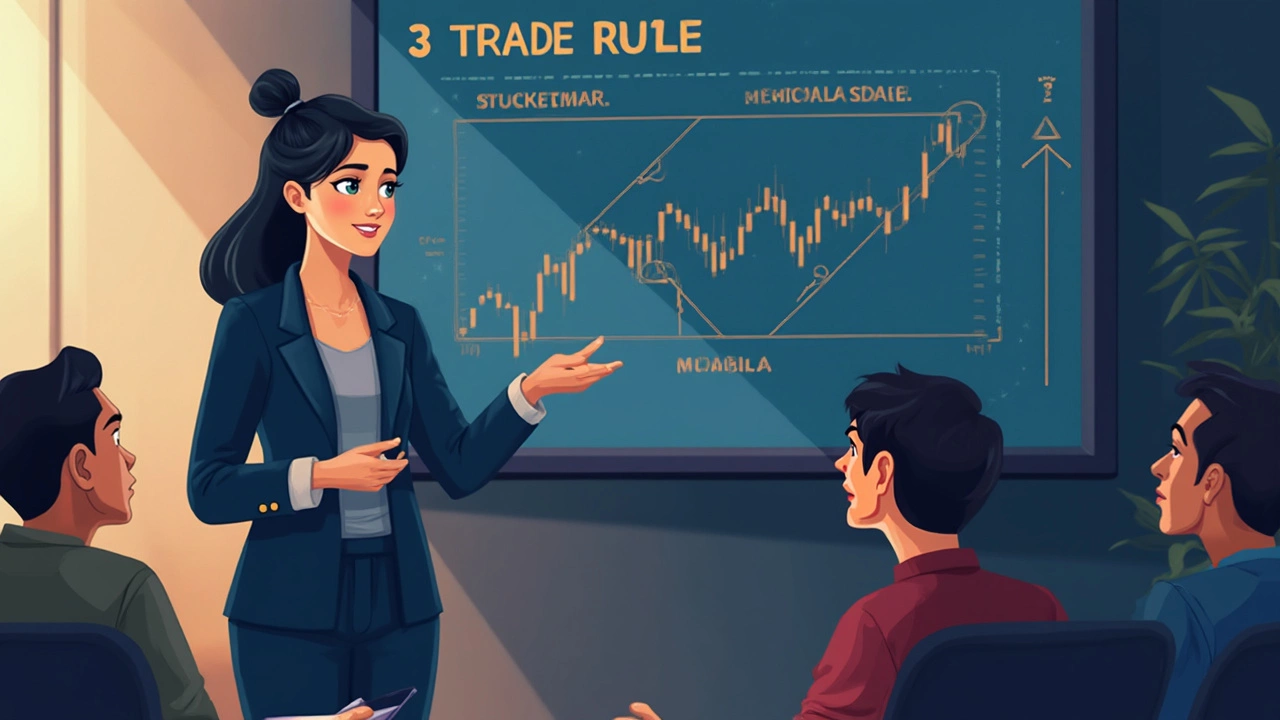So you’re excited about trading stocks but keep running into talk about the “3 trade rule.” Sounds mysterious, right? But here’s the deal: it could seriously mess with how often you can buy and sell shares—especially if you’re working with a smaller account.
The 3 trade rule comes from the FINRA ‘Pattern Day Trader’ regulation. If you make more than three day trades—that’s buying and selling the same stock within a single day—in a rolling five-business-day period, and your account is under $25,000, you get flagged as a Pattern Day Trader. Suddenly you need a bigger bankroll, or your broker might just lock you out from trading. Not fun.
Imagine this: You quickly flip stock trades to jump on price swings, thinking you’re hustling, only to get that dreaded broker notification. It’s happened to plenty of newbies because brokers aren’t always great at warning you upfront. That’s why understanding the rule from the start keeps you in charge, not scrambling after the fact.
- What Is the 3 Trade Rule?
- Why the Rule Exists and Who It Affects
- Tips to Avoid Pattern Day Trader Status
- Smart Ways to Handle Trading Restrictions
What Is the 3 Trade Rule?
The so-called 3 trade rule is mostly about day trading in the stock market. Here’s what it really means: If you make more than three day trades within five business days, and your margin account is under $25,000, you’ll get marked as a “Pattern Day Trader” (PDT) by your broker. At that point, your account faces restrictions that can slow you down or, worst case, freeze your ability to buy and sell until you deposit more cash.
So what exactly counts as a day trade? It’s when you buy and then sell (or sell short and then buy back) the exact same stock or ETF in one trading day. If you open and close a position before the market’s closing bell, it’s a day trade. Simple as that.
- Make one or two day trades in five days? No problem.
- Three day trades? Still okay.
- Make that fourth one? Now you’re flagged as a Pattern Day Trader if your account’s below $25,000.
This rule comes from FINRA (the Financial Industry Regulatory Authority) and applies to U.S. stock markets. It only counts if you use a margin account—cash accounts work differently, so this rule doesn’t hit you the same way there. Also, the limit resets every rolling five-day window, not just a Monday-to-Friday week. So if you trade Monday, Tuesday, and Friday, your clock starts back up based on those days, not just a regular week.
The main takeaway: The 3 trade rule means you really need to track those quick trades if you don’t have a $25,000 balance. A lot of beginners get tripped up here, thinking they can just jump in and out of stocks all week. Then, boom, their broker puts up a wall and they can’t keep trading until rules are followed or their balance goes up. No one wants that surprise.
Why the Rule Exists and Who It Affects
If you’re wondering why there’s even a limit on day trades, it all comes down to keeping folks safe from blowing up their accounts with risky moves. In 2001, the Financial Industry Regulatory Authority (FINRA) and the SEC noticed a bunch of beginner traders making split-second decisions, racking up big losses, and sometimes draining their accounts in a single day. That’s why they gave us the Pattern Day Trader (PDT) rule—aka the 3 trade rule—to slow things down for small accounts.
Here’s who gets hit by this rule: anyone with a margin account under $25,000 who makes more than three day trades within any five business days. If you’re trading with less than $25k, and you break the rule, your broker can restrict your account so you’re only allowed to close positions for a while, or even freeze your trading outright. If you only have a cash account, you avoid this rule, but you’re limited by how long it takes for trades to settle (the so-called T+1 or T+2 rules).
| Account Type | Day Trading Limit | Impacted by PDT? |
|---|---|---|
| Margin (Under $25,000) | 3 trades in 5 days | Yes |
| Margin (Over $25,000) | No fixed limit | No |
| Cash Account | Depends on cash available | No |
Why target small accounts? The regulators figure that folks without a big cash cushion might be tempted to take on outsized risk, get caught by short-term swings, or even turn to borrowing (aka margin) to chase quick gains. Setting the bar at $25,000 keeps those slip-ups in check, at least for the most impatient traders.
Day traders with big accounts aren’t really slowed down, but smaller traders have to play it safer, plan better, or wait between moves. If you just dip in and out of trades once in a while, you’ll be fine. But if you like the adrenaline of frequent trades, this rule is the main speed bump you’ll keep running into.

Tips to Avoid Pattern Day Trader Status
Getting slapped with that Pattern Day Trader label is a headache, especially if you’re not ready to keep $25,000 in your trading account. The good news? You actually have some pretty straightforward moves to dodge the 3 trade rule headache and keep trading on your terms.
- Count your day trades: Every time you buy and sell the same stock (or option) in a single day, that’s one day trade. Keep track. Most mainstream broker apps like Robinhood, TD Ameritrade, and E*TRADE now show you a live tally, but double-check—mistakes happen.
- Spread trades out: Do a max of 3 day trades during any rolling five-business-day window in accounts under $25,000. If you need to make more, you’ll need to beef up your cash balance—no magic workaround.
- Switch to swing trading: Buy and hold your stocks for more than a day—even just overnight—and you’re no longer day trading. Plenty of sharp traders use this as a workaround and find better profits over several days.
- Use multiple brokers (carefully): Some folks split their trading between two brokerages to sneak in more trades. Just be careful, as this requires a tight handle on your records—get sloppy, and you might blow past the rule accidentally.
- Try cash accounts: Cash accounts are only limited by settled funds, not by the day-trade rule. But remember: in a cash account, buying power is only restored once funds settle (usually two business days after a sell). No instant re-use like in margin accounts.
Here’s how things shake out for small-time traders versus those with heftier accounts:
| Account Balance | Day Trades Allowed (Per 5 Days) | Pattern Day Trader Risk |
|---|---|---|
| Under $25,000 | 3 | High |
| Over $25,000 | Unlimited | None |
If your account does get flagged, your broker usually gives you a warning first. Don’t ignore it—otherwise, you might get stuck for 90 days with your trades locked down.
The key is to stay organized. Check your trade history every week, watch your brokerage dashboard notifications, and always know how many intraday flips you’ve done lately. Simple planning saves you big headaches.
Smart Ways to Handle Trading Restrictions
So you hit the 3 trade rule wall. Now what? Don’t just cross your fingers and hope the broker doesn’t notice. There are some simple, proven ways to deal with these trading speed bumps and still stay active in the market.
First off, the easiest way around the rule: keep fewer than four day trades in any five-day window. Sounds obvious, but you’d be amazed by how often people lose count. Take a few seconds after every trade and jot it down somewhere you won’t forget—your phone’s notes app does the trick. Some trading platforms show a day trade counter, but don’t rely on these to be perfect.
If your account balance is under $25,000 and you want to trade more, you’ve got some options:
- Move to a cash account instead of a margin account. With cash accounts, you can make unlimited trades—but you have to wait for your funds to settle before making another trade. U.S. stock trades usually settle in two business days (known as T+2), so plan ahead.
- Build your account above $25,000. Once your balance crosses that magic number, the pattern day trader restriction disappears, and you can day trade as much as you want. According to FINRA data, most U.S. retail traders keep accounts under $10,000, so this isn’t always an overnight fix.
- Use multiple brokerage accounts. If you split your trades between different brokers, you can do three day trades with each account every five days. It takes more organization but helps maximize your trading without breaking a single rule.
- Try swing trading instead of day trading. Swing trading means holding stocks longer than a day—so you dodge the restriction, still make regular trades, and often lower your stress levels.
Also, keep an eye out for your broker’s warnings. Many brokers, like Robinhood and Fidelity, display alerts once you’re close to your third day trade. Read them and don’t ignore them—it could mean the difference between full trading access and an account freeze.
If you do get tagged as a Pattern Day Trader, your options get slim. The broker could freeze your account for 90 days or only let you close, not open, positions. Sometimes, you can ask for a one-time reset, but brokers only do this once per account, if at all.
| Broker | Day Trade Limit (under $25,000) | Margin Account Required? |
|---|---|---|
| Robinhood | 3 per 5 days | Yes |
| Fidelity | 3 per 5 days | Yes |
| Charles Schwab | 3 per 5 days | Yes |
The bottom line? You can still be an active trader without tripping the pattern day trader wire. Stay organized, choose your account type wisely, and play by the rules—it keeps things smooth and your account alive. No one likes a trading timeout.

